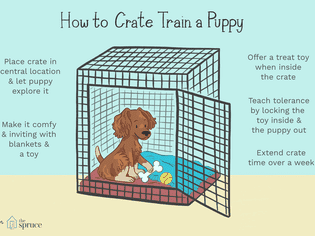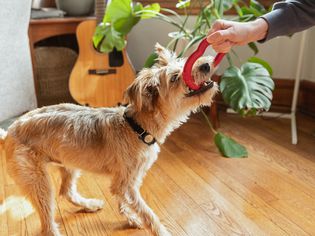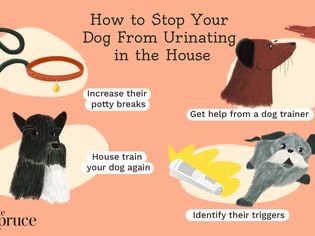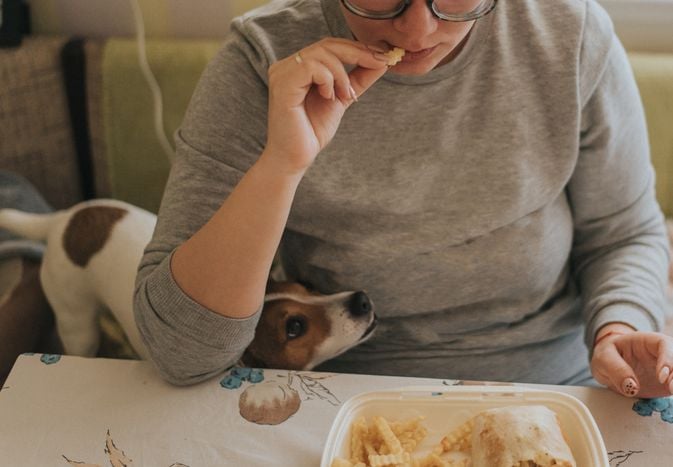There are a number of reasons to crate train your dog. Most puppies and adult dogs feel more secure in a small, enclosed den-like area, and young puppies are especially eager to find a safe place. A carefully-chosen crate and proper crate training can help your puppy discover that a crate is a safe, happy place to spend the night. A youngster should be introduced slowly to the crate when possible and not left unattended longer than the dog is able to "hold it" for potty training. But crate training, when it's done right, can give both you and your dog a feeling of order and security in a complex world.
Watch Now: How to Crate Train Your Puppy
Consider the Goals of Crate Training
Crate training serves a number of purposes, all of which can make your home and your dog's life easier. So already knowing about and accepting a crate should be part of your puppy’s training.
- A crate works well as a bed. Because it’s enclosed, the puppy crate also serves as a safe retreat to get away from other pets or children.
- A crate also can be a safe place to confine a rambunctious puppy. That keeps the pup out of trouble when you aren’t able to watch it.
- Most dogs must be confined from time to time, when they travel by car or stay at the veterinarian, for example.
- A crate is one of the best tools available for helping to potty train your puppy. Dogs won't willingly soil their own beds, so they are highly motivated to "hold it" while in their crate.
Select the Ideal Crate
The perfect crate should be just large enough for a puppy to go inside, turn around, and lie down to sleep, but not so large that your dog can soil one side of the crate and sleep on the other side. Of course, puppies grow. So take into account your pup’s future adult size before investing in a pricey dog crate. Large crates are available with partitions for you to “shrink” to puppy size, and then enlarge the area as your puppy grows. You can also purchase an adult-size crate, and insert a barrier like a plastic storage box that shrinks the space to puppy proportions until your pet grows into its crate.
Most crates are made of solid hard plastic or wire mesh; there are advantages to each. While soft-sided pet carriers work great for transport, they may be too small and prove too tempting for chew-aholic pups to work well for safe confinement. Solid plastic crates are generally opaque, so your dog won't be able to see much once it's inside. This can be either a plus or a minus, depending on your dog's need for privacy and the type of household it lives in. Plastic crates are a must if you plan to travel by air: airlines will not allow you to transport your dog in a metal crate. Wire crates offer plenty of air and visibility and are easy to clean. They can also be folded down and put away when not in use, which is a terrific feature for a smaller home.
Introduce the Crate
Make the crate a familiar item. While well-adjusted puppies tend to be curious, some tend toward shyness. Anything new prompts suspicion. So make the crate “part of the furniture” and set it out in the family room for your new puppy to explore. Leave the door open and let the pup sniff it inside and out.
Set up the Crate
You want to make the crate a happy place. Place a snuggly blanket or dog bed inside. Or you can toss a toy inside, and encourage your pup to go get it. You want your dog to have positive experiences with the crate. Another idea is to find a puzzle toy that can be stuffed with a smelly, tasty treat. This should be a treat your puppy loves, but can only enjoy when inside the crate.
Teach Crate Tolerance
Show it to the dog, let it smell and taste the treat, and then toss it inside the crate and shut the door, with the puppy outside the crate and the treat on the inside. That shows that an absolutely scrumptious puppy treat is inside, out of paw-reach. And after the pup has begged and scratched and whined to get inside, open the door and let it get the toy inside the crate. Allow your pup to chew and enjoy it for five minutes with the door shut and the dog remaining in the crate. Some pups settle down and enjoy their treat with no fanfare. Others throw a fit and want out. So if your puppy fusses let it out, but lock the treat back inside. You’re teaching the dog that wonderful things can be found inside the crate. Most pups learn to tolerate the door shut at least as long as they have something to munch.
Extend Crate Time
Over a week’s period or so, increase the length of time that the puppy stays inside the crate with the treat toy. In between training periods, just leave the door open. You might be surprised how often a worn-out puppy seeks out crate time on its own for a nap or to get away from the rest of the household.
Once your puppy accepts the crate as a fact of puppy life, you can move the crate to a more acceptable spot in the house. A place next to your own bed will let the puppy sleep in its own spot but near your familiar smells and presence. That also offers you a more private area to seclude it, when necessary, from activities in the living area or kitchen that might keep your dog overstimulated.
Problems and Proofing Behavior
Ideally, your puppy will welcome and even enjoy spending time in the crate. One common mistake is to use the puppy’s crate as the place of punishment because this makes it more difficult for the puppy to consider it a pleasant experience.
Still, some puppies may have a harder time adjusting to the crate than others. Another common mistake is to expect your pup to love the crate right away. If your new pet is really crate-averse, try a new type of crate. Some dogs may prefer wire crates so they can still see their environment, while others may be the exact opposite. Also, try putting the crate in a different place. Some dogs may prefer their crate in the center of the family action while others might like it in a quieter corner of the house.










Comments on " Crate Training Your Puppy" :